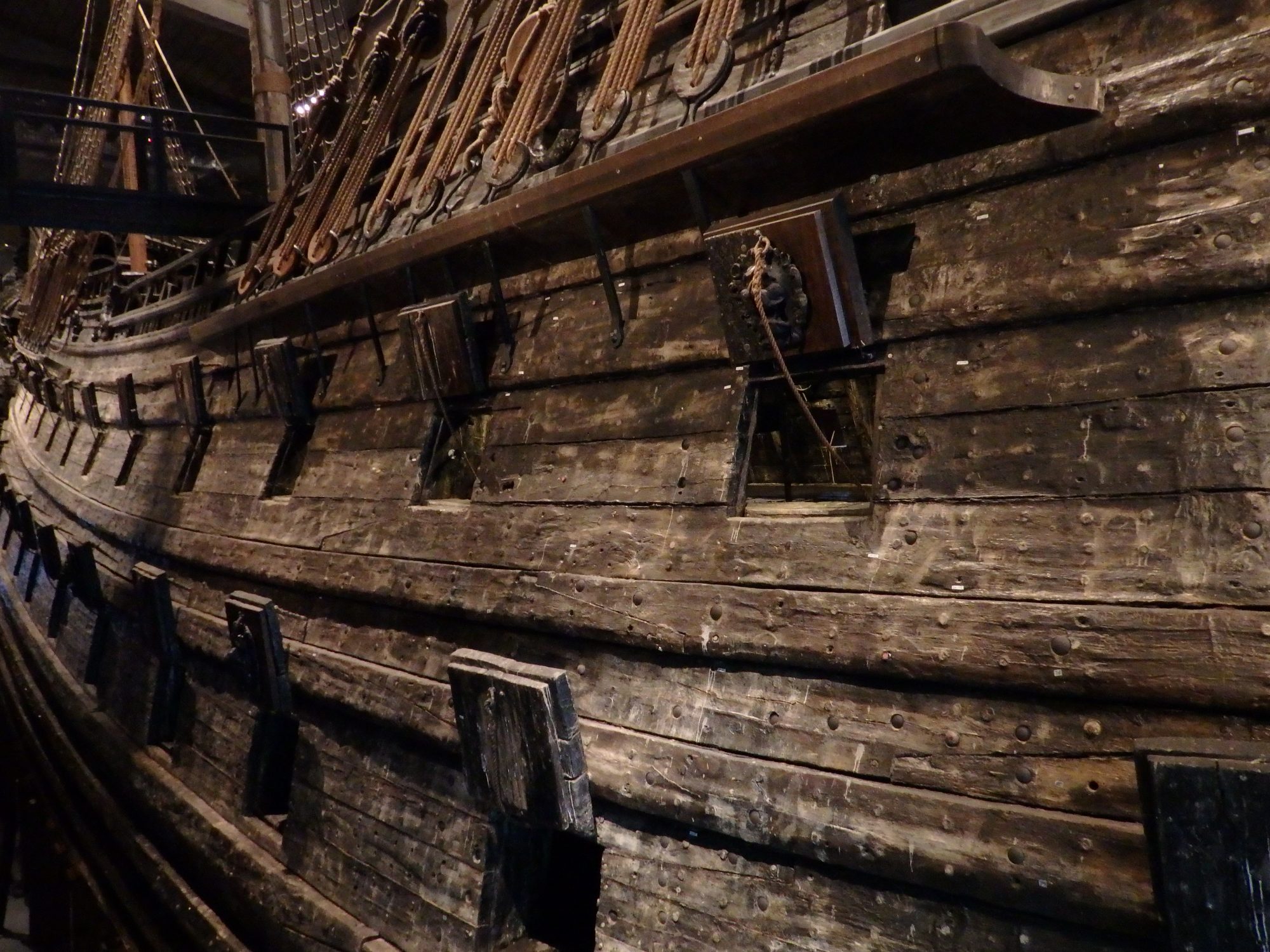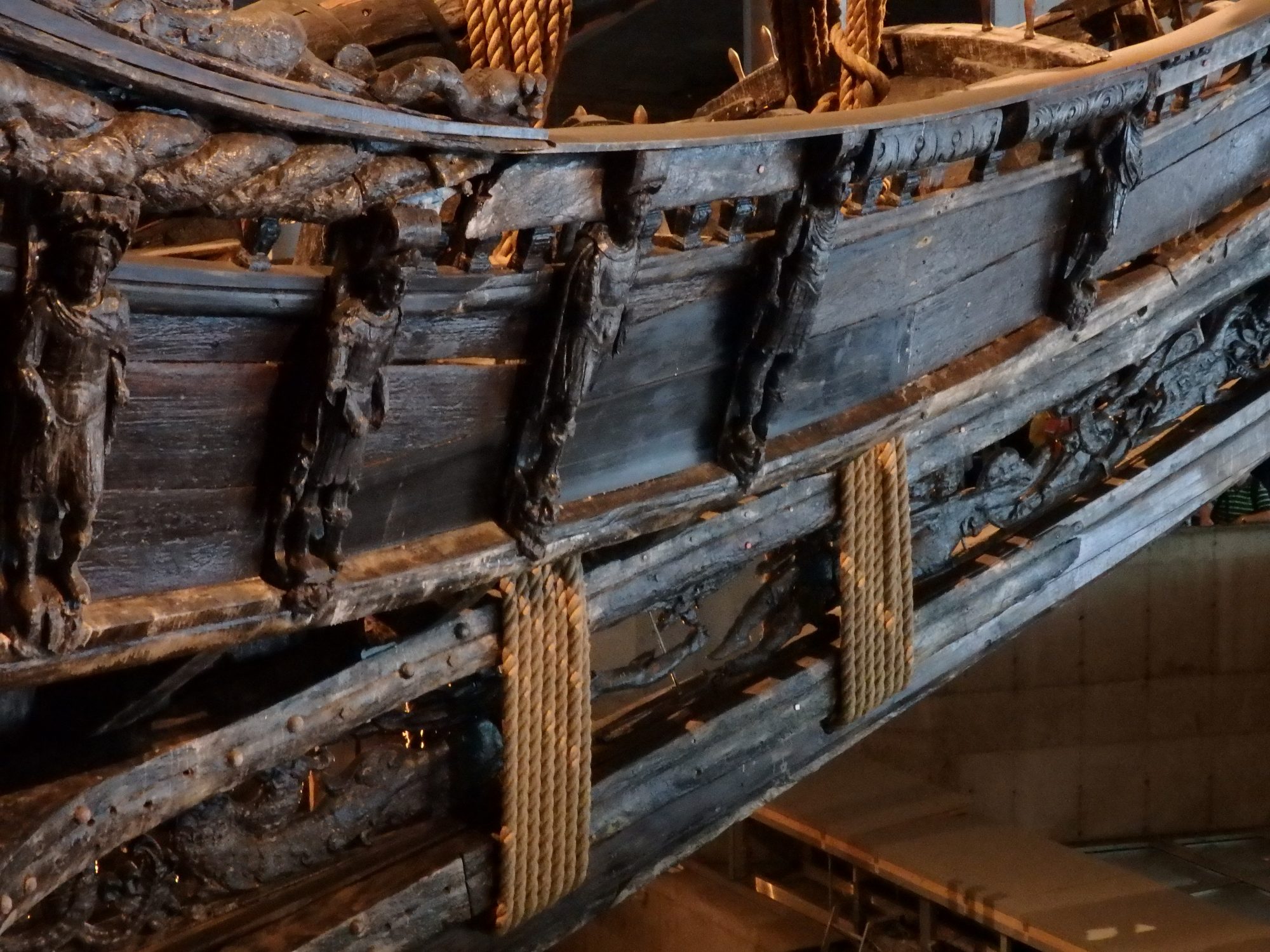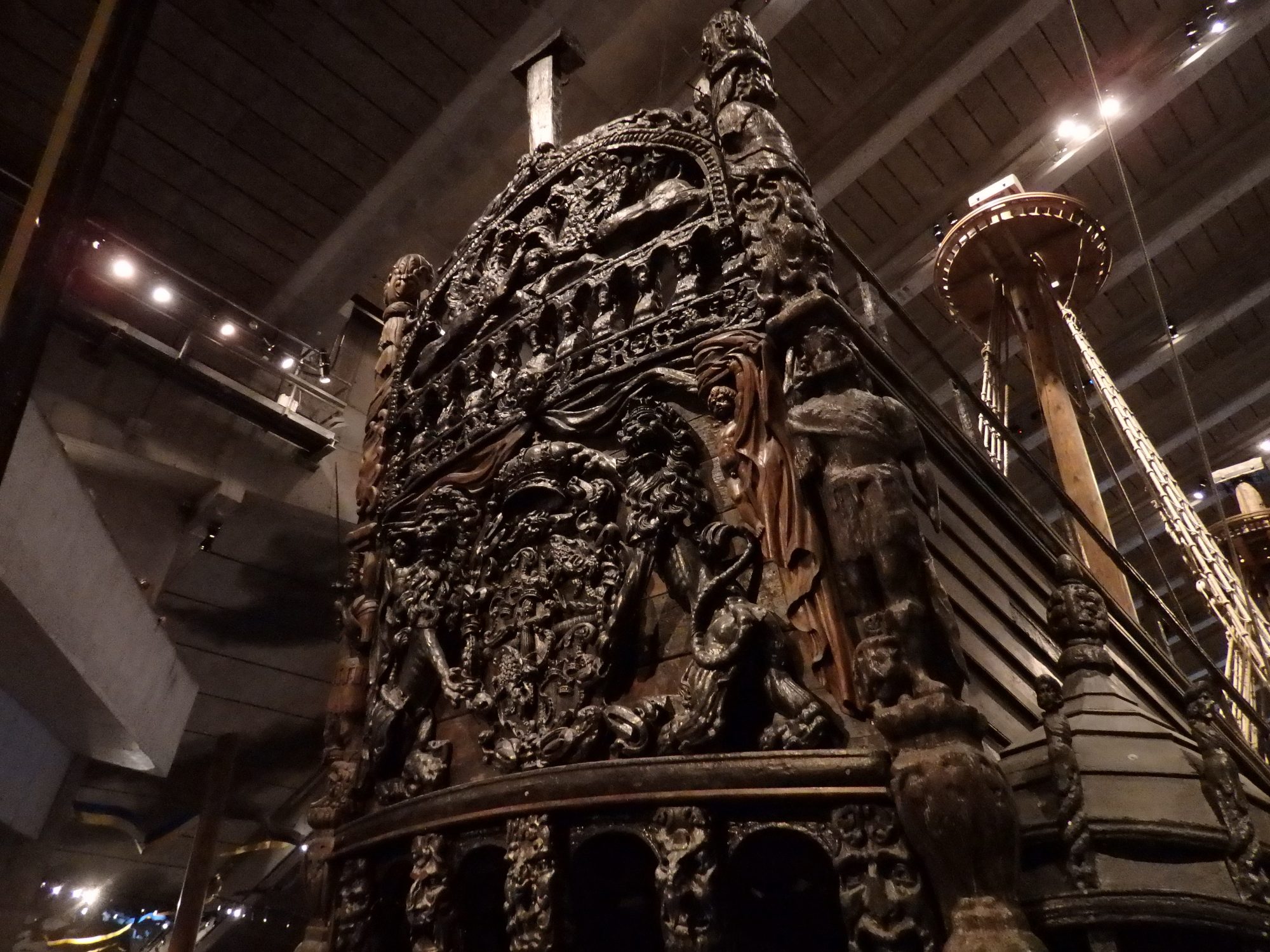The Vasa Museum: exploring an epic fail
Ever notice how people love to hear about failed projects? I call it “epic fail tourism.”
The most obvious example is the Titanic, about which there are numerous museums around the world (Belfast, Ireland, where the Titanic was built; Branson, Missouri; Pigeon Forge, Tennessee; Orlando, Florida; Southampton, England, where many victims were from; and many more).
The Vasa Museum in Stockholm houses a similarly good example of an epic fail that took place hundreds of years before the Titanic.
Disclosure: I received a free Stockholm Pass as a participant in the TBEX conference in Stockholm in July 2016. This allowed me free admission to the Vasa Museum. The museum also sponsored a party for TBEX participants, so I got an additional viewing with better lighting one evening. Nevertheless, all opinions expressed here are my own.

The Vasa story
The King of Sweden, Gustavus Adolphus, ordered the Vasa in 1626 as the first of a series of warships to use in his ongoing war with Poland.
The Vasa was not only a standard-issue warship, however. The king intended it to represent Swedish power (Sweden controlled much of present-day Sweden, plus most of Finland and Estonia) to all enemies or potential enemies. The ship was designed by a Dutch shipwright, Henrik Hybertsson.

To emphasize Sweden’s power and wealth, besides arming it to the teeth (two gundecks instead of the usual one: enough to hold 72 cannons), the builders covered it with at least 500 ornate, brightly-painted carvings and statues. They were meant to represent Sweden’s power and included references to Roman emperors, Biblical figures, and mythical creatures. On either side of the bow, sculptures of Polish noblemen crouch in a humiliating position: are they begging? Bowing?
Here are some other articles you might enjoy:
What happened to the Vasa
The big day arrived: August 10, 1628. The boat, carrying 64 cannons, sailed into Stockholm harbor with all the cannon ports open to fire a salute to mark the departure of the boat.
After about 20 minutes, in the middle of the harbor, a gust of wind hit it broadside and it heeled (tilted). Heeling was, and is, normal for a sailboat, but this one had some serious faults in the design:
- It was not well-proportioned: 69 meters long, originally 52 meters high, 11.8 meters wide. That made it too narrow and too tall. This could have been compensated for with a deep enough keel with enough weight on it, but this ship’s center of gravity was too high. The carvings decorating the ship added weight high up, as did all of the cannons on its gundecks.
- At the same time, the lower gundeck’s cannon ports were just a meter and a half above the water line.
The combination of these two faults meant that the boat, when the gust hit it, leaned steeply, and water gushed into the hold through the bottom row of cannon ports. The boat filled quickly with water and sank, settling on the seabed with about 20 meters of masts still showing above the water.

There were about 150 people on board, but most of them either managed to swim to shore nearby or were plucked from the water by people on the many boats that had assembled in the harbor to watch the launch. It is estimated that about 30 to 50 people died.
For much more, sometimes comical, detail about how the Vasa sank, read Anda Galffy’s post called, “Vasa, the Swedish Navy Ship That Never Sailed.”
A sister ship, built under the same contract as the Vasa, was the same except for being a meter wider, and it lasted 30 years.
If you like boats, you might also like this post on the USS Pampanito and the SS Jeremiah O’Brien or this one on the Houseboat Museum in Amsterdam!
The Vasa, 300 years later
The Vasa sat on the ocean floor for more than 300 years until 1959, when a salvage operation began. The ship was brought to the surface in 1961.
What’s amazing about the Vasa is that it survived all of that time under water more or less intact. The water in the Baltic has a low salt content, and at the same time it stays cold enough that the shipworms that would eat the wood in warmer climes can’t survive. The metal bolts rusted away, but 98% of the salvaged ship is the original wood. The pieces in currents eroded, but the ones that sank into the mud stayed in much better condition.
The Vasa Museum in Stockholm was built especially to hold the reassembled ship, giving visitors a priceless view of a 17th century Swedish warship. After paying your entrance fee, you open a shaded glass door to enter the main hall, and that first glimpse of the ship is truly a “wow moment.”
You can walk around the ship at several levels, admiring the sculptures, mostly still in remarkable shape.
Displays arranged around the ship illustrate other aspects of the story. The society of the time, the details of the ship and its use, a mock-up of what the cannon deck would have looked like, a film on how the ship was salvaged, examples of sculpture copies, painted as the originals would have looked, artifacts that were salvaged along with the ship. It’s captivating in so many ways.

Visitors do a lot of disbelieving head-shaking at the stupidity that led to the Vasa’s sinking. I can imagine that it was, in the end, fortunate that the designer died before completion of the ship. Nevertheless, this epic fail gives us an amazing gift: a view of a nearly intact 17th century warship, and a glimpse into the society and the power that built it.
Have you ever visited the Vasa museum or done any other “epic fail tourism”? Tell us about it in the comments below!
Click here to visit a top 10 list of what to see in Stockholm on another blog: Travel Notes and Beyond.



vey cool! I’ve not done epic fail tourism (I think). seen a Titanic exhibit at Mystic Seaport in Connecticut but not sure it had anything to do with the Titanic. For that matter, what does Branson Missouri have to do with the Titanic saga?
I have no idea! I saw a Titanic exhibit once too, but I can’t for the life of me remember where. It might have been the Southampton one.
Wow such an interesting background!
I love a good story!
I was aware to the Vasa. it’s a fascinating story.
The story of the Swedish ship, Vasa, is fascinating from its inception and maiden “voyage” to its remarkable state of preservation. The detailed carving is incredible. Sweden’s epic fail looks like it’s a win to me and others who love glimpses back in time!
Definitely!
What a fascinating ship! It’s a shame we have to label things ‘epic fails’ – I like to think that we visit places or objects because we’re interested in them. This warship, despite its failings, is truly beautiful from your photos.
I’d love to visit it and see it in all its glory.
It’s not a phrase I use much, but in this case it certainly was an epic fail at the time. I agree, though, that I would have visited it even without the back story, just because I love historic ships. And this is a truly magnificent example!
An epic fail indeed! But, by way of contrast, the restoration of the Vasa is a real success story, leading to a wonderfully preserved ship for us to look at today. (I understand that the techniques developed were later used on England’s Mary Rose warship.)
Absolutely! Their misfortune was our gain!
Looks like a very cool museum for history geeks such as I. Hmm. Epic historical fails? If you think about it, most battlefields are the site of one side’s epic fail. In my home state of Pennsylvania, Gettysburg springs to mind — if you wish the Confederacy won the Civil War—which I don’t. 😉 How about the Berlin Wall?
Of course you’re right. Every battle lost is an epic fail. Maybe what makes the Titanic and the Vasa perticularly interesting is how high the expectations were.
Never visited an epic fail that I can remember. I missed the Vasa when visiting Stockholm so I loved visiting virtually with you!
Glad you enjoyed it!
I enjoyed reading this post and the accompanying photographs. Interesting stuff.Thanks for the tour.
Peta.
Glad you liked it!
Loved the post! I agree wholeheartedly – seeing the Vasa was a ‘wow’ moment.
I went during the day, and then again during the party at night. I spent a moment at the party watching a few people enter. There was an audible “Wow!”
They say that pride goes before the fall … in this case, it seems to have gone before the sinking of the Vasa!
Haha! Exactly!
Right now, I do not remember visiting an “epic fail” but I know people love to hear the things that went wrong while you were on vacation. I have been talking about a trip and people ask me to skip to the juicy details. That is when I know they want to hear about the bad experiences during the trip (I still do not get why they like that). I have heard about the Vasa before but didn’t know the story behind. Very interesting!
There’s a reality show on Dutch TV that’s all about how people’s vacations went wrong. It’s like slowing down to look at a car accident on the highway. Something in human nature, I suppose…
How incredible that it was so well preserved after 300 years. Just as well it sunk so close to shore so that most survived. It would have been grisly if it had managed to sail further!
True! At least they had a chance in the harbor!
I didn’t even know Vasa Museum exist! I can see why it gave you a “wow moment.” Thanks for sharing 🙂
Thanks!
Great post -you are way ahead of me in posting!
How long have you been doing Travel Photo Thursday?! I used to participate all the time, then sort of dropped off. Guess I’ll have to rejoin.
I’ve been doing it for a while, but not always consistently. Sometimes I’m just too busy to add it to the post, and it really should go up on the Thursday! Glad you liked the post!